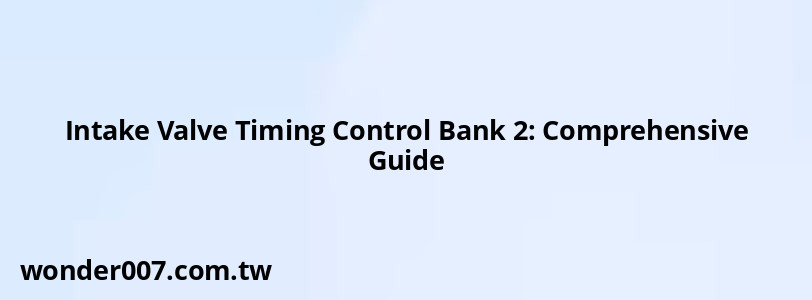Intake Valve Timing Control Bank 2: Comprehensive Guide

The intake valve timing control system on Bank 2 plays a critical role in optimizing engine performance by adjusting the timing of the intake valves. This system ensures efficient combustion, improved fuel economy, and enhanced power delivery across different engine speeds.
Intake Valve Timing Control Bank 2
What is Bank 2?
- Bank 2 refers to the side of the engine that does not include cylinder #1. This designation is typically used in V6, V8, or other multi-bank engines.
- The intake valve timing control system on Bank 2 adjusts the opening and closing of the intake valves to optimize airflow into the engine.
How Does It Work?
- The system uses variable valve timing (VVT) technology to adjust camshaft timing based on engine conditions.
- An intake valve timing control solenoid regulates oil flow to the camshaft actuator, which adjusts the camshaft's position.
- This process is managed by the engine control module (ECM), which receives input from sensors like the crankshaft and camshaft position sensors.
Common Issues and Symptoms
When there is a problem with the intake valve timing control on Bank 2, it can trigger diagnostic trouble codes (DTCs) such as P0028 or P0021. Symptoms may include:
- Poor engine performance: Reduced power or acceleration.
- Rough idling or stalling: Irregular engine operation at low speeds.
- Check Engine Light (CEL): Illuminated CEL due to detected faults in the system.
- Increased fuel consumption: Inefficient combustion leading to higher fuel usage.
Causes of Problems in Intake Valve Timing Control Bank 2
Several factors can lead to issues with this system:
- Faulty solenoid valve: The intake valve timing control solenoid may be damaged or clogged.
- Low or dirty engine oil: Insufficient oil pressure or contamination can affect solenoid and actuator performance.
- Wiring issues: Damaged or corroded wiring in the solenoid circuit can disrupt communication with the ECM.
- Sensor malfunctions: Faulty crankshaft or camshaft position sensors can provide inaccurate data to the ECM.
- Mechanical wear: Problems with the timing chain, tensioner, or camshaft actuator.
Diagnosing and Fixing Issues
Diagnosis
1. Use an OBD-II scanner: Retrieve DTCs like P0028 or P0021 to pinpoint the issue.
2. Inspect components:
- Check the intake valve timing control solenoid for damage or blockage.
- Examine wiring and connectors for corrosion or breaks.
- Verify oil levels and quality.
3. Test sensors: Use a multimeter to check crankshaft and camshaft position sensor outputs.
Repairs
- Replace a faulty solenoid with a new one that meets manufacturer specifications.
- Perform an oil change if oil is dirty or low, ensuring proper viscosity as per vehicle guidelines.
- Repair or replace damaged wiring and connectors in the solenoid circuit.
- Clean or replace the oil control valve if necessary.
- Address mechanical issues like worn timing chains or actuators.
Preventive Maintenance Tips
To avoid problems with intake valve timing control:
- Regularly change your engine oil and use high-quality oil filters.
- Inspect wiring and connectors during routine maintenance.
- Address warning signs like rough idling or reduced power promptly.
FAQs About Intake Valve Timing Control Bank 2
- What does Bank 2 mean?
Bank 2 refers to the side of a multi-bank engine that does not contain cylinder #1. - What causes a P0028 code?
This code indicates an issue with the intake valve control solenoid circuit on Bank 2, often due to a faulty solenoid, wiring issues, or low oil pressure. - How much does it cost to fix?
Repairs can range from $100 for a simple solenoid replacement to $600+ for more complex issues involving timing chains.
Related Posts
-
How To Check Mileage On Cadillac CTS: A Complete Guide
29-01-2025 • 236 views -
3.5 Ecoboost Camshaft Position Sensor Location Guide
28-01-2025 • 219 views -
2015 Hyundai Genesis Navigation SD Card Guide
27-01-2025 • 147 views -
Chevy Malibu Won't Start: Troubleshooting Guide
27-01-2025 • 156 views -
Replace Brake Light Switch on 2002 Honda Accord: A Step-by-Step Guide
26-01-2025 • 218 views
Latest Posts
-
Rear Brake Caliper Piston Won't Compress
01-02-2025 • 356 views -
2015 Chevy Traverse AC Recharge Port Location
01-02-2025 • 409 views -
Power Steering Fluid Leak On Passenger Side
01-02-2025 • 457 views -
Are O2 Sensors Covered Under Warranty
01-02-2025 • 376 views -
How To Turn Off Paddle Shifters Mercedes
01-02-2025 • 377 views
Popular Posts
-
EPC Warning Light: What It Means for Your Vehicle
27-01-2025 • 630 views -
Hino Warning Lights: Understanding Dashboard Alerts
26-01-2025 • 765 views -
Power Steering and ABS Light On: Causes and Solutions
27-01-2025 • 643 views -
V12 Engine Costs: What You Need to Know
26-01-2025 • 679 views -
EPC Light: Understanding Causes and Solutions
26-01-2025 • 1053 views
